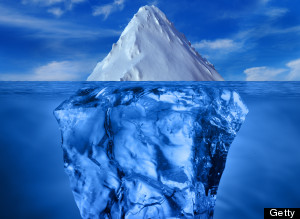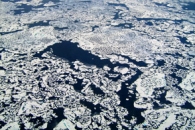这两天报纸上都登着剑桥大学的研究报道
简略小结一下有关报道:
1. 北极圈和东俄罗斯海洋下的冰山包含着很多沼气
2. 水下冰山在融化,并且在加速
3. 融化的冰导致大量沼气进入大气层,引起温度上升,加速融化, 再导致沼气更加速释出...正循环过程..
(以上是NASA 2012 的观察, 下面的第一篇文)
4. 估计今后几十年平均温度上升2..5-3.5C
5. 沼气会使得海洋酸化,影响整个海洋生态
6. 剑桥大学根据NASA对沼气释出的估计, 作了大量模拟, 估计对全球经济有 $60trillion 的影响,相当于去年全球经济总产值
鼓励小中投身其中. 从科研, 工程, 到政府政策, 公众科普教育, 等等, 都去做力所能及的事.
有办法影响中国政府和民众, 更好.
剑桥大学Wadham领导的研究虽有争议, 但NASA的卫星观察是确实的, 并且证实了俄国科学家更早期的地面观察.
----------
示意图:

卫星拍摄的, 沼气释放改变了北极圈的冰面:

Nasa:
The fragile and rapidly changing Arctic is home to large reservoirs of methane, a potent greenhouse gas. As Earth’s climate warms, that methane is vulnerable to possible release into the atmosphere, where it can add to global warming.
Researchers have known for years that large amounts of methane are frozen in Arctic tundra soils and in marine sediments (including gas hydrates). But now a multi-institutional study led by Eric Kort—now at NASA’s Jet Propulsion Laboratory after conducting the research at Harvard University—has uncovered a surprising and potentially important source of methane: the Arctic Ocean itself.
The photograph above was taken by Kort, and it shows leads and cracks in the ice cover of the Arctic Ocean north of Alaska. During five research flights in 2009–10, Kort and colleagues measured increased methane levels while flying at low altitudes north of the Chukchi and Beaufort Seas in a National Science Foundation/National Center for Atmospheric Research (NCAR) Gulfstream V aircraft as part of the HIAPER Pole-to-Pole Observations (HIPPO) airborne campaign.
The methane level detected during the flights was about one-half percent higher than normal background levels. But where was the methane coming from? The team detected no excess carbon monoxide in the atmosphere, which would have been a signature of methane coming from the human combustion of fuels. And based on the time of year, the location, and the nature of the emissions, it was unlikely that the methane was coming from high-latitude wetlands or geologic reservoirs.
By comparing the locations of the enhanced methane levels with airborne measurements of carbon monoxide, water vapor, and ozone, the researchers from six institutions pinpointed a source: the ocean surface, in places where there were cracks and openings in the sea ice cover. The cracks were allowing methane in the top layers of the sea to escape into the atmosphere. The team did not detect enhanced methane levels over areas of solid ice.
Kort noted that previous studies had detected high concentrations of methane in Arctic surface waters, but no one had predicted that this dissolved methane would find its way into the overlying atmosphere. Scientists are not yet sure how the methane is produced, but Kort suspects biological productivity in Arctic surface waters may be the culprit.
“While the methane levels we detected weren't particularly large, the potential source region, the Arctic Ocean, is vast,” he said. “Our finding could represent a noticeable new global source of methane.”
-----------
Cost of Arctic methane release could be 'size of global economy' warn experts
Researchers have warned of an "economic time-bomb" in the Arctic, following a ground-breaking analysis of the likely cost of methane emissions in the region. Economic modelling shows that the methane emissions caused by shrinking sea ice from just one area of the Arctic could come with a global price tag of 60 trillion dollars -- the size of the world economy in 2012.
Writing in a Comment piece in the journal, Nature, academics argue that a significant release of methane from thawing permafrost in the Arctic could have dire implications for the world's economy. The researchers, from Cambridge and Rotterdam, have for the first time calculated the potential economic impact of a scenario some scientists consider increasingly likely -- that methane from the East Siberian Sea will be emitted as a result of the thaw.
This constitutes just a fraction of the vast reservoirs of methane in the Arctic, but scientists believe that the release of even a small proportion of these reserves could trigger possibly catastrophic climate change. According to the new assessment, the emission of methane below the East Siberian Sea alone would also have a mean global impact of 60 trillion dollars.
The ground-breaking Comment piece was co-authored by Gail Whiteman, from Erasmus University; Chris Hope, Reader in Policy Modelling at Cambridge Judge Business School, University of Cambridge; and Peter Wadhams, Professor of Ocean physics at the University of Cambridge.
"The global impact of a warming Arctic is an economic time-bomb," Whiteman, who is Professor of sustainability, management and climate change at Rotterdam School of Management, Erasmus University (RSM), said.
Wadhams added: "The imminent disappearance of the summer sea ice in the Arctic will have enormous implications for both the acceleration of climate change, and the release of methane from off-shore waters which are now able to warm up in the summer. This massive methane boost will have major implications for global economies and societies."
Most discussion about the economic implications of a warming Arctic focuses on benefits to the region, with increased oil-and-gas drilling and the opening up of new shipping routes that could attract investments of hundreds of billions of dollars. However, the effects of melting permafrost on the climate and oceans will be felt globally, the authors argue.
Applying an updated version of the modelling method used in the UK government's 2006 Stern Review on the Economics of Climate Change, and currently used by the US Environmental Protection Agency, the authors calculate the global consequences of the release of 50 gigatonnes of methane over a decade from thawing permafrost beneath the East Siberian Sea.
"The methane release would bring forward the date at which the global mean temperature rise exceeds 2 degrees C by between 15 and 35 years," said Chris Hope. "In the absence of climate-change mitigation measures, the PAGE09 model calculates that it would increase mean global climate impacts by $60 trillion."
If other impacts such as ocean acidification are factored in, the cost would be much higher. Some 80% of these costs will be borne by developing countries, as they experience more extreme weather, flooding, droughts and poorer health, as Arctic warming affects climate.
The research also explored the impact of a number of later, longer-lasting or smaller pulses of methane, and the authors write that, in all these cases, the economic cost for physical changes to the Arctic is "steep."
The authors write that global economic institutions and world leaders should "kick-start investment in rigorous economic modelling" and consider the impacts of a changing Arctic landscape as far outweighing any "short-term gains from shipping and extraction."
They argue that economic discussions today are missing the big picture on Arctic change. "Arctic science is a strategic asset for human economies because the region drives critical effects in our biophysical, political and economic systems," write the academics. Neither the World Economic Forum nor the International Monetary Fund currently recognise the economic danger of Arctic change.
According to Whiteman, "Global leaders and the WEF and IMF need to pay much more attention to this invisible time-bomb. The mean impacts of just this one effect -- $60 trillion -- approaches the $70-trillion value of the world economy in 2012."
Source: University of Cambridge